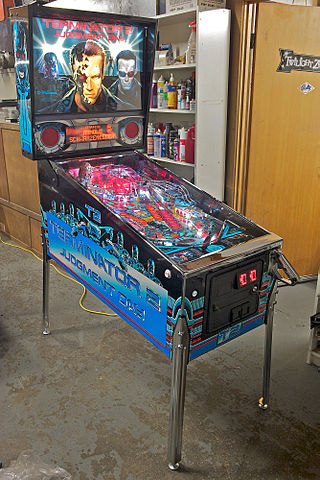
Pinball games are a family of games in which a ball is propelled into a specially designed table where it bounces off various obstacles, scoring points either en route or when it comes to rest. Historically the board was studded with nails called 'pins' and had hollows or pockets which scored points if the ball came to rest in them. Today, pinball is most commonly an arcade game in which the ball is fired into a specially designed cabinet known as a pinball machine, hitting various lights, bumpers, ramps, and other targets depending on its design.
A glossary of terms, commonly used in discussing pinball machines.

Medieval Madness is a Williams pinball machine released in June 1997. Designed by Brian Eddy and programmed by Lyman Sheats, it had a production run of 4,016 units. As of December 7, 2024, the Pinside pinball community lists it as the #2 highest-ranked pinball machine ; many adherents consider it the greatest of all time.
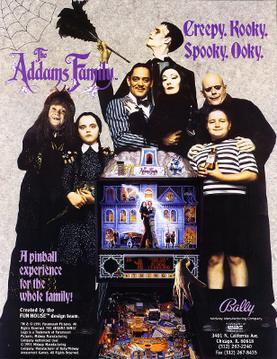
The Addams Family is a pinball machine released in March 1992. It was designed by Pat Lawlor and Larry DeMar and released by Midway. It was based on the 1991 film of the same name, and features custom speech by the stars of the film, Anjelica Huston and Raul Julia. It is the best-selling solid state pinball machine of all time with 20,270 units sold.

Star Trek: The Next Generation is a widebody pinball game, designed by Steve Ritchie and released in November 1993 by Williams Electronics. It was part of WMS' SuperPin series, and was based on the TV series. It is the only pinball machine that features three separate highscore-lists. Apart from the regular highscore-list and the buy-in-list, it also features a reminiscence to The Machine: Bride of Pin*Bot billionaires club. It is also the third pinball game overall based on the Star Trek franchise, following the 1979 pinball game by Bally, and the 1991 game by Data East, and preceding the 2013 pinball game by Stern.

Cirqus Voltaire is a 1997 pinball game, designed by John Popadiuk and released by Williams Electronics Games. The theme involves the player performing many different marvels in order to join the circus. Some of the game's distinctive features include a neon light running along the right-hand ramp, a pop bumper that rises up from the middle of the playfield at certain times, and a magnet at the top of the left ramp that can catch balls and divert them into the locks. The most notable feature is the Ringmaster, a head that rises at certain times and taunts the player.

Attack from Mars is a 1995 pinball game designed by Brian Eddy, and released by Midway.

The Getaway: High Speed II is a 1992 pinball game by Steve Ritchie. It is a sequel to 1986's High Speed.
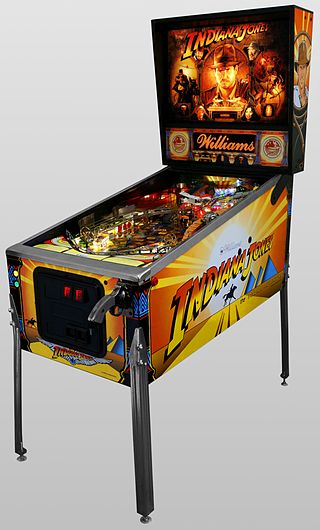
Indiana Jones: The Pinball Adventure is a 1993 widebody pinball game designed by Mark Ritchie and released by Williams. It was based on the Indiana Jones movies. It was also part of WMS' SuperPin series of widebody games.
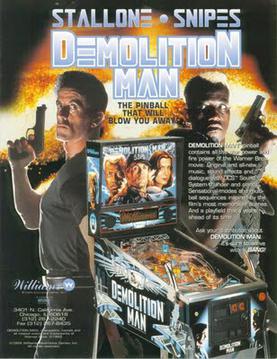
Demolition Man is a Williams pinball machine released in February 1994. It is based on the motion picture of the same name. It is part of WMS' SuperPin line of widebody games.
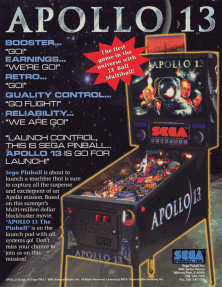
Apollo 13 is a 1995 pinball machine based on the film Apollo 13. It was designed by Joe Kaminkow and Joe Balcer, and released by Sega Pinball. It is notable for its 13-ball multiball mode, the largest of any pinball machine ever made.
Doctor Who is a pinball machine designed by Bill Pfutzenreuter (Pfutz) and Barry Oursler, and released by Midway in September 1992. It is based on the television series Doctor Who. As stated in the Gameplay section, the rulesheet is rather different from other pinball machines released at the time, which didn't help popularity as casual players did not understand the complex rule changes that occur during the game.

No Fear: Dangerous Sports is a 1995 pinball game designed by Steve Ritchie and released by Williams. It is based on the clothing line. This game has an extreme sports theme and features skydiving, free climbing, water skiing, extreme skiing, supercross and NASCAR racing. This was the last game Steve Ritchie designed for Williams.

Star Wars Episode I is a 1999 pinball game designed by John Popadiuk and released by Williams and the second machine to use the Pinball 2000 hardware platform. It is based on the first installment of the Star Wars prequel trilogy, The Phantom Menace.
Theatre of Magic is a pinball machine designed by John Popadiuk, produced by Midway. The player assumes the role of a novice magician who must develop their skills by exploring the titular theatre and performing an assortment of stage illusions.
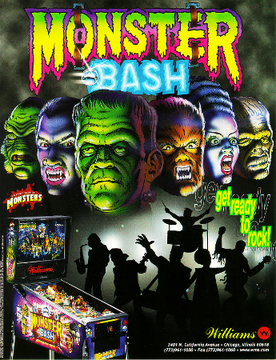
Monster Bash is a pinball machine produced by Williams. The game features some Universal Monsters including The Creature from the Black Lagoon, The Wolf Man, Frankenstein's monster, the Bride of Frankenstein, Dracula and The Mummy.

Creature from the Black Lagoon is a pinball machine designed by John Trudeau and released by Midway. It is loosely based on the movie of the same name. The game's theme is 1950s drive-in theater. The pinball game was licensed from Universal Studios by Bally so that all backglass and cabinet artwork and creature depictions would resemble those of the original movie.

Whirlwind is a pinball machine produced by Williams in 1990 and was one of the last Williams System 11b games. It was designed by Pat Lawlor, who created a previous natural disaster-themed pinball for Williams, Earthshaker!.

Judge Dredd is a four-player pinball game produced by Bally Manufacturing in 1993, based on the British comic strip Judge Dredd in 2000 AD. Nearly 7,000 were made.
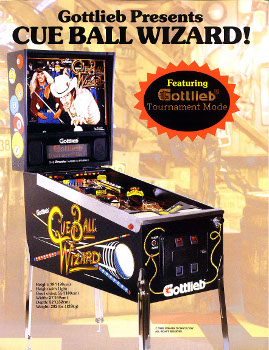
Cue Ball Wizard is a pinball machine designed by Jon Norris and released in December 18 1992 by Gottlieb. It features a cue sports theme and was advertised with the slogan "Gottlieb Presents CUE BALL WIZARD!".

















